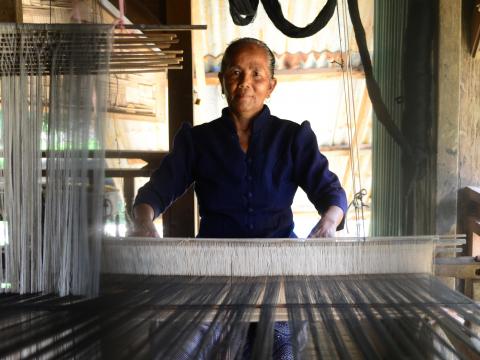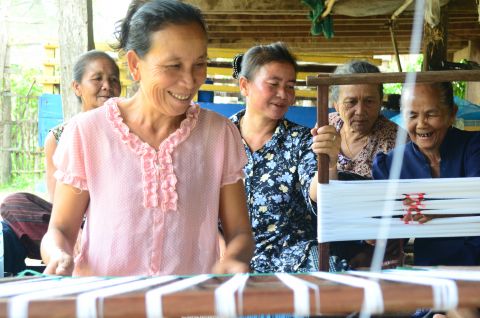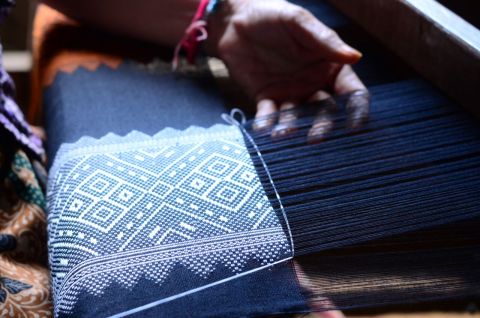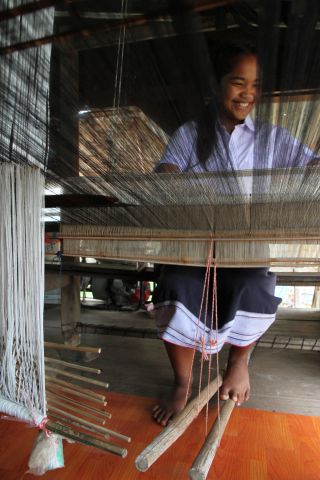An ancient art and an escape from poverty

It’s seen resurgence in North America and parts of Europe. But the traditional art has also reappeared in a forest village in the south of Laos.
“It’s the tradition from generation to generation,” Sogaa explains, a 42-year-old mother of four.
Sogaa is among a group of grandmothers in one southern Laos community using weaving as their tool to escape the clutches of poverty.

Everyday, these 5 women sit in front of a loom and carefully entwine thread resulting in intricate handwoven fabric that will later be transformed into skirts, shawls, table clothes or wall hangings.
Before
Many of the women in this World Vision weaving group learned to weave as children, watching their mothers trying it for themselves.
“The first time I tried to weave I broke part of the machine and clogged it up. I was fooling around with it while my mom was away. I was afraid my mom would be angry. But she wasn’t,” Kamghut says.

Kongkham, a 62-year-old grandmother of 18, remembers hand picking cotton and spinning it to get the material. She recalls how they used to make the threads colourful, by grinding up leaves and seed form the forest.
“To get the dark brown colour, we used buffalo dung and tree leaves and would ground it up,” she remembers, laughing.
War
Weaving stalled - was nearly lost here - during the Vietnam War.
“They bombed here a lot. The planes came all day, all night. They came, and a bomb fell here,” Kongkham says while pointing to a pond a few metres away from her house. “There are many craters here. They are all bomb holes.”
When she became a young mother herself, she says she had no choice but to flee.
Life after the war
“In 1975 we got to come home,” Kongkham says.
The village was destroyed, but Kongkham and the 100 or so families dedicated themselves to rebuilding it. They planted rice. They hunted in the jungle. They fished in the stream.
Life was a struggle. “I don’t want to think about the past, we were too poor,” says Khamghut, who is 10 years younger than Kongkham.
As for weaving, although looms were rebuilt, there was rarely enough time to do anything beyond surviving.
The craft was being lost.
Modern days

Ten years ago, a road was finally built to this village. Electricity followed two years later.
No longer were families isolated from the outside world. The new road brought visitors, and one of those groups of visitors was World Vision.
Together, World Vision and the local government authority started to help farm families improve their annual income- new rice seeds for better harvests, a fund to buy goats and animal vaccinations. It improved income and allowed for people to have some free time.
World Vision also put out a call for women interested in weaving. Five women volunteered- four grandmothers and Khamghut- a childless married women raising her niece. The organization helps provide equipment to repair the looms and provided stock- cotton, dye and other necessary material- for the women to restart.
On average, the women weave 15 skirts per month or several metres of fabric- that sell for about 8 to 10 USD. It’s allowed women to feel economically empowered.
“Women have to wear the Lao skirt. It’s our tradition.”
It has also allowed for the next generation to start weaving. The women talk about daughters and nieces who help and have started creating their own fabric on their looms. And for 15-year-old Kitsaana, it’s unleashed a creative outlet.
“I saw my aunt doing it (weaving) and it seemed like a lot of fun so I just learned. I like making fabric. I find it quite easy. I love the designs that are pink, yellow or orange,” she shares.
“I’ll do it forever,” says the Grade 8 student. “Women have to wear the Lao skirt. It’s our tradition.”